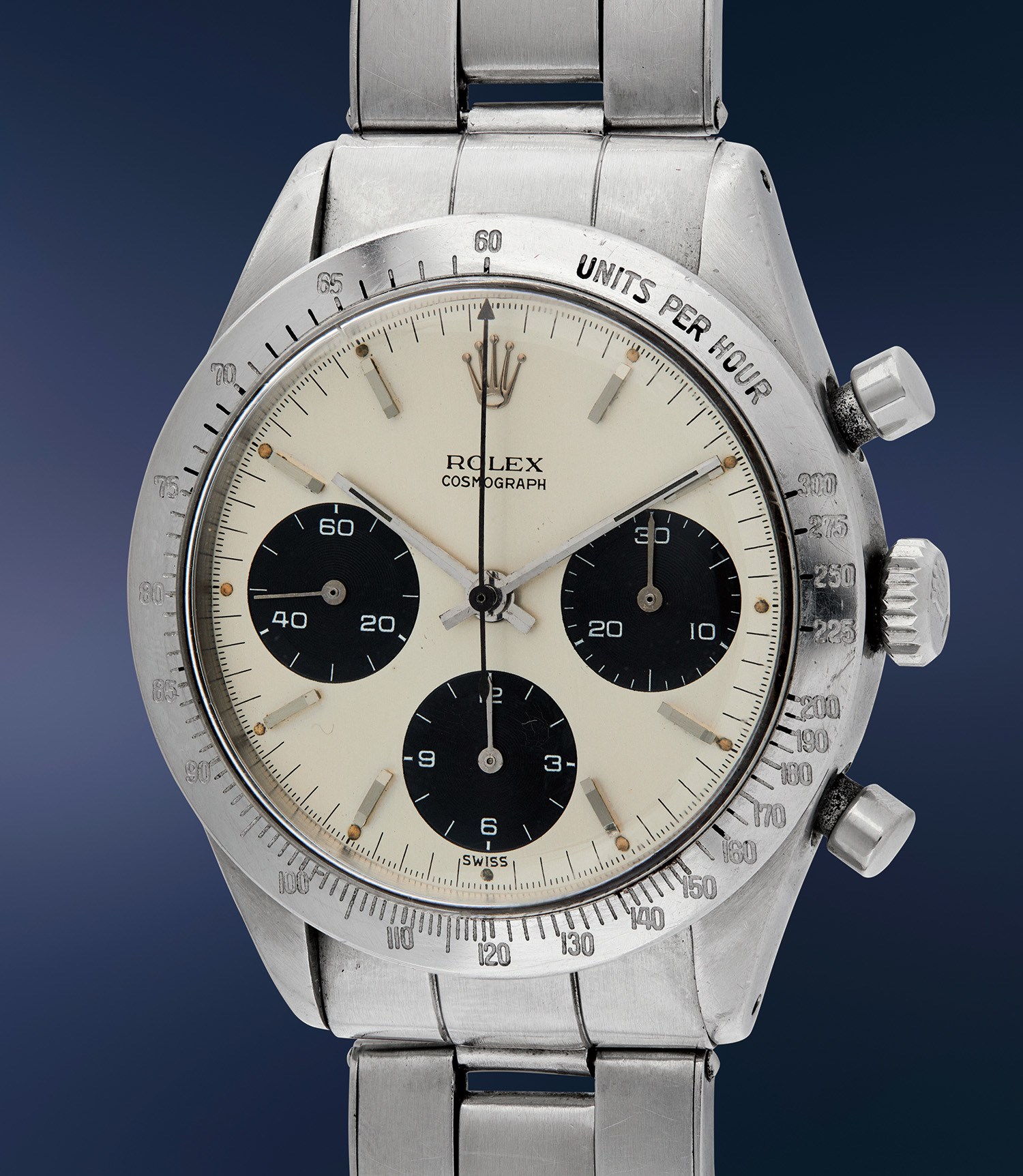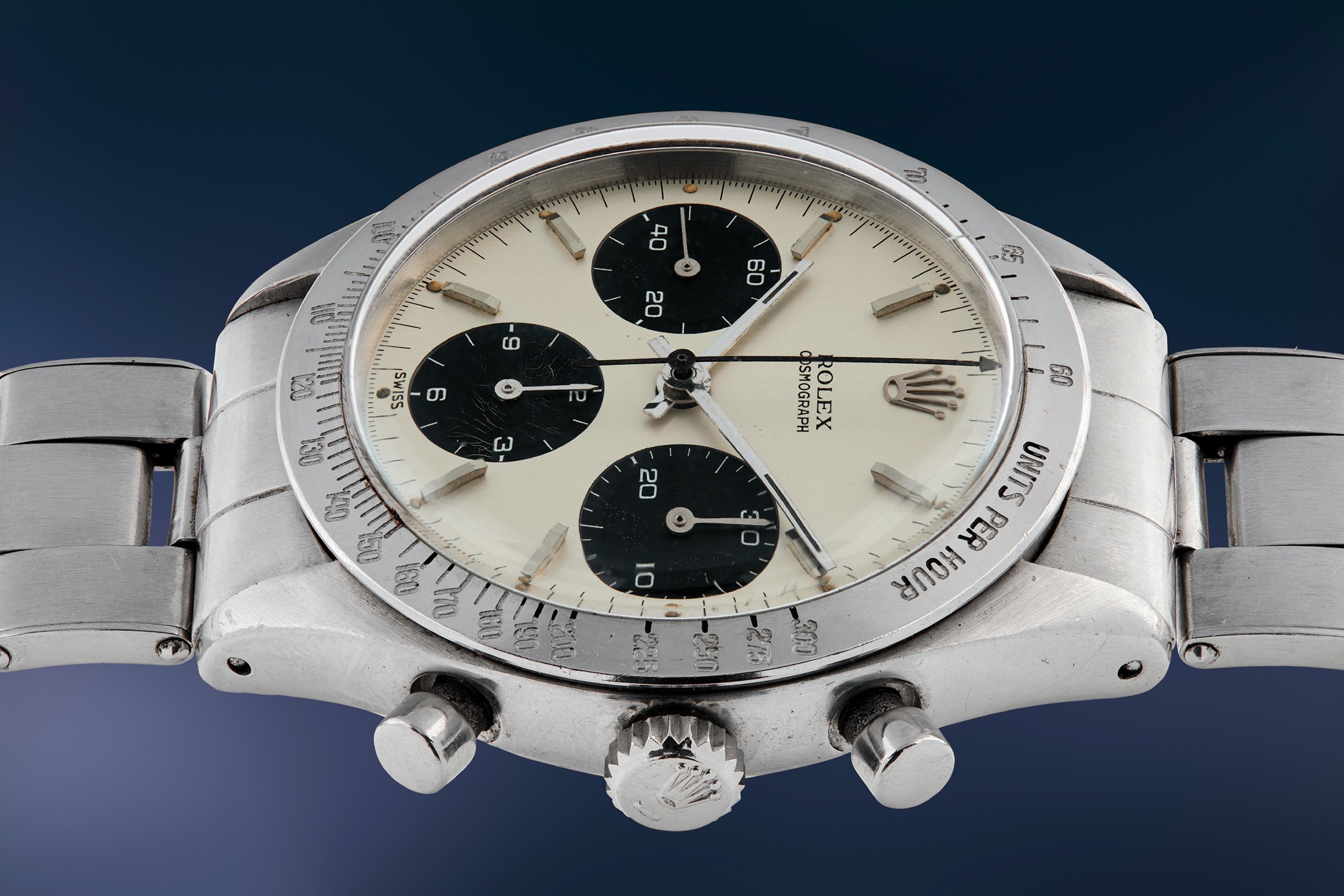





31
Rolex
Ref. 6239; inside caseback stamped 6238
Cosmograph Daytona
An extremely early and interesting stainless steel chronograph wristwatch with bracelet and “Swiss” only dial
Full-Cataloguing
Rolex launched their new line of sports chronographs with an external bezel with the references 6239 (metal) and 6241 (acrylic). The very earliest dials fitted to these references were the “double Swiss” dials well-known to the Rolex collecting community. Double Swiss dials are identified by having two “Swiss” designations at 6 o’ clock, one visible and the other mostly hidden by the case.
Less known are the dials directly after the “double Swiss” but before the “T-Swiss-T”: the “Swiss”-only, such as the present lot. It seems for a short period, Rolex fixed the placement of the “Swiss” designation, only to have to alter it to accommodate the introduction of tritium luminous material and the introduction of the “T”.
These “Swiss”-only early Daytonas bear extremely early serial numbers, but all directly after the “double Swiss” examples. The earliest example of a Rolex Daytona sold by Phillips is an example also sold in the Christie’s Daytona: Lesson ONE auction, a similar white dial, metal bezel 6239 bearing case number 923’192. The latest bears case number 923’349. The current lot, with case number 923’392, can be considered the beginning of the change – the next batch of Daytonas would have a T-Swiss-T designation.
The tiny printing at the foot of the dial is not the only rare feature of this particular Cosmograph Daytona. If one studies the dials of these early “silver” 6239s versus their later counterparts, the color and treatment of the dial is distinctly different. One example, sold in Phillips’ 2018 Daytona Ultimatum sale with a white grèné dial, was nicknamed “The Gandalf” (though of course, this would be Gandalf after his battle with the Balrog in the depths of Khazad-dûm, and not Gandalf Greyhame), and the aforementioned earliest example sold by Phillips bears a similar white dial, versus the silver soleil dials seen on later dials and all future iterations of manually-wound Daytona. The present 6239 has an opaline silvery-white dial that is immediately distinctive. Furthermore, the watch is fitted with a highly rare Mark I bezel calibrated to 300 units per hour and notably featuring small hashmarks rather than the dots and hashes of later bezels.
Purchased directly from the original owner by the consignor, rarely are we able to present such appealing academic examples that have never been seen publicly before. Each example such as this one brings our community’s understanding of vintage Rolex closer to completion, and reminds one of why we began this pursuit in the first place. To not only be able to study these details, but marvel at their beauty, is truly a privilege.
Rolex
Swiss | 1905Founded in 1905 England by Hans Wilsdorf and Alfred Davis as Wilsdorf & Davis, it soon became known as the Rolex Watch Company in 1915, moving its headquarters to Geneva in 1919. Like no other company, the success of the wristwatch can be attributed to many of Rolex's innovations that made them one of the most respected and well-known of all luxury brands. These innovations include their famous "Oyster" case — the world's first water resistant and dustproof watch case, invented in 1926 — and their "Perpetual" — the first reliable self-winding movement for wristwatches launched in 1933. They would form the foundation for Rolex's Datejust and Day-Date, respectively introduced in 1945 and 1956, but also importantly for their sports watches, such as the Explorer, Submariner and GMT-Master launched in the mid-1950s.
One of its most famous models is the Cosmograph Daytona. Launched in 1963, these chronographs are without any doubt amongst the most iconic and coveted of all collectible wristwatches. Other key collectible models include their most complicated vintage watches, including references 8171 and 6062 with triple calendar and moon phase, "Jean Claude Killy" triple date chronograph models and the Submariner, including early "big-crown" models and military-issued variants.